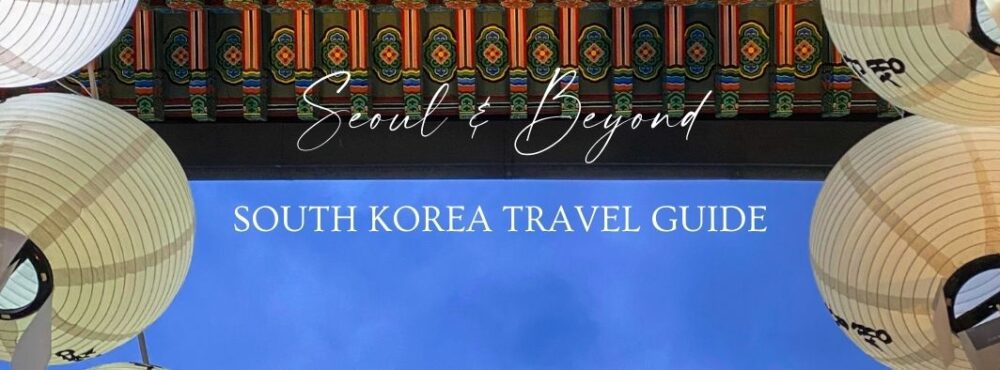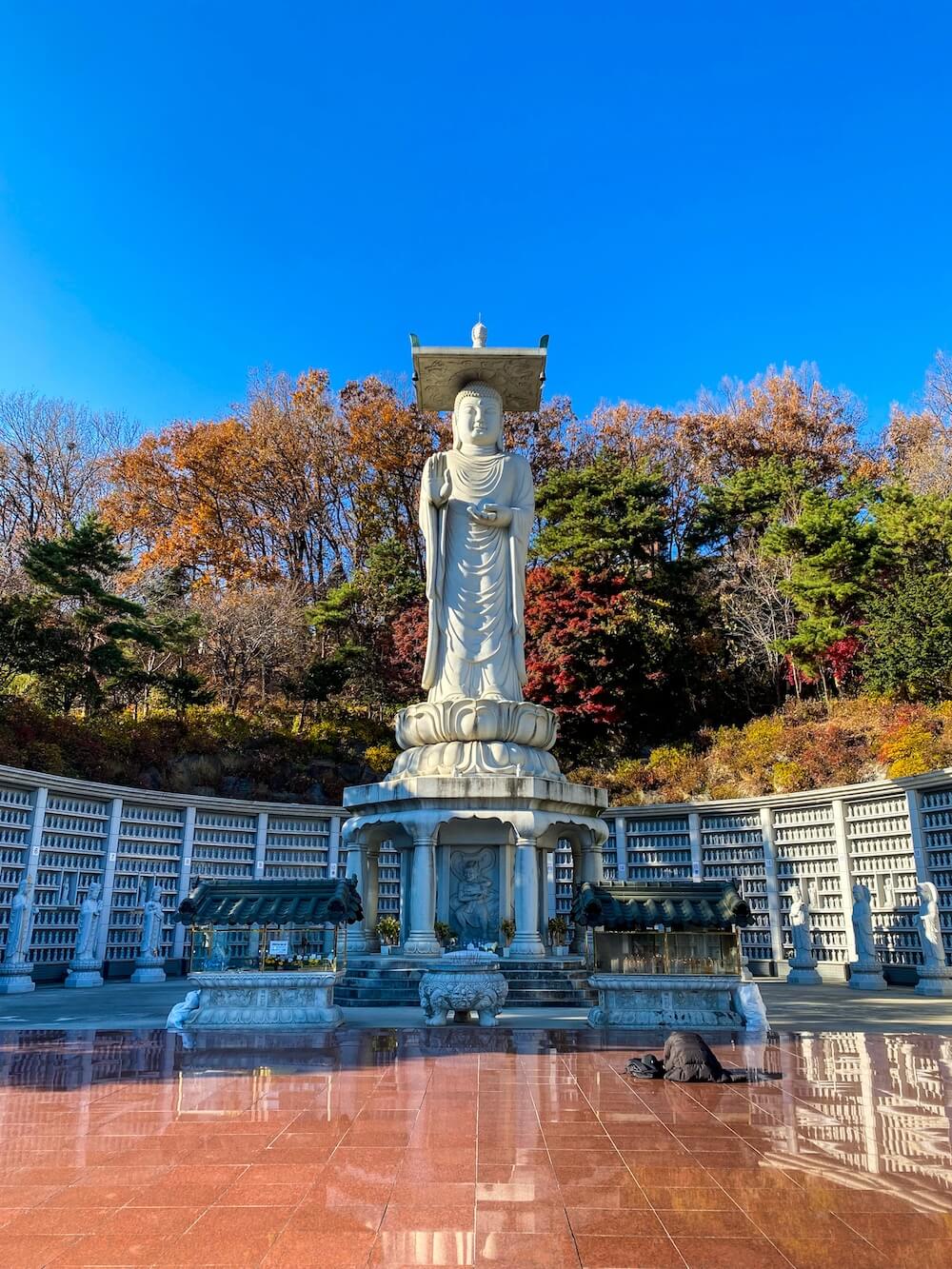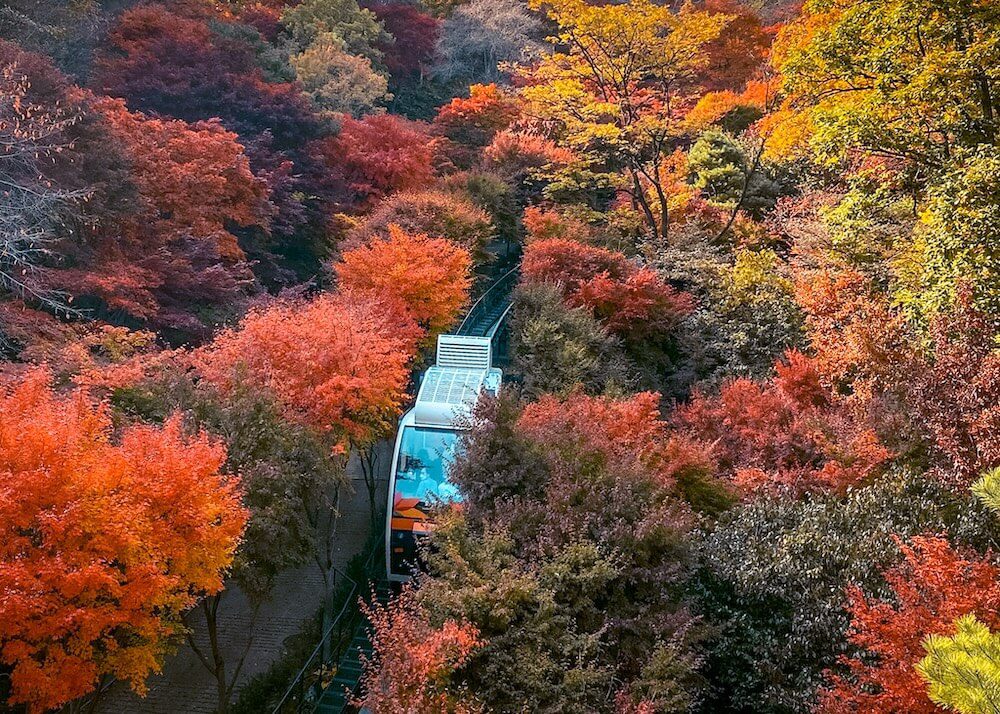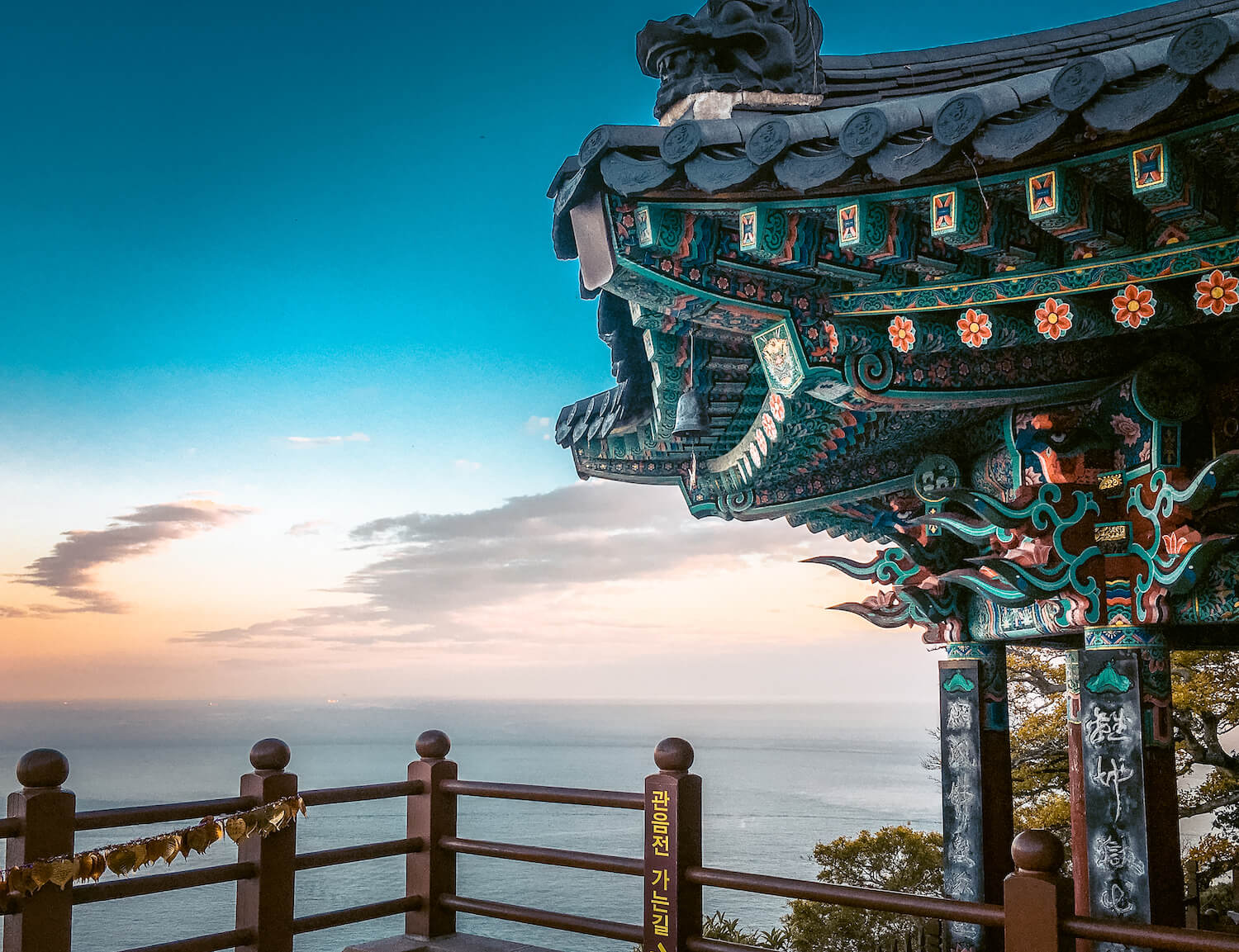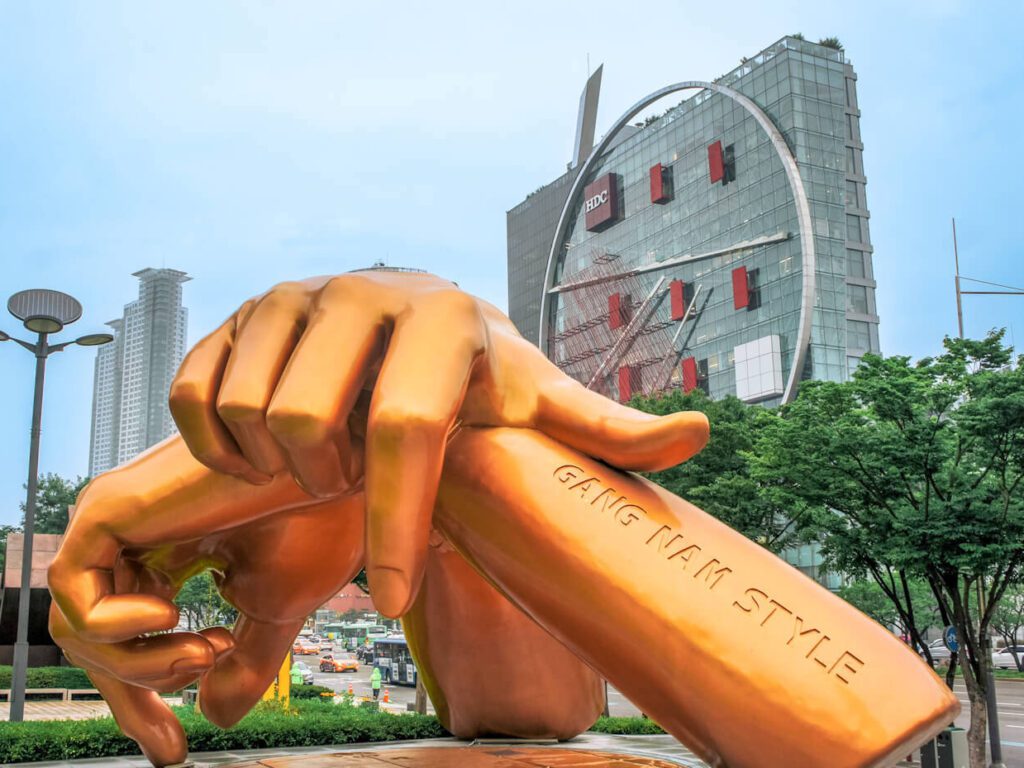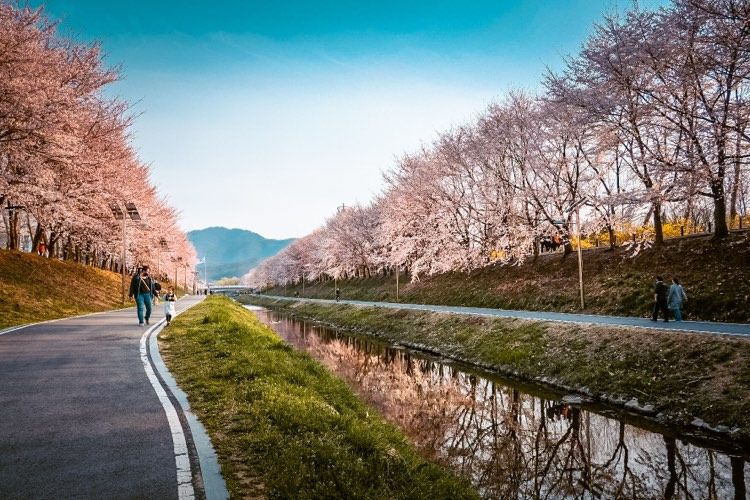Bongeunsa Temple Seoul | The Serene 1,200 Year Old Temple where Ancient & Modern Meet in Gangnam
With its unique location in the heart of wealthy, modern Gangnam, Bongeunsa Temple is absolutely one of the best places in Seoul to experience the stark contrast of old and new.
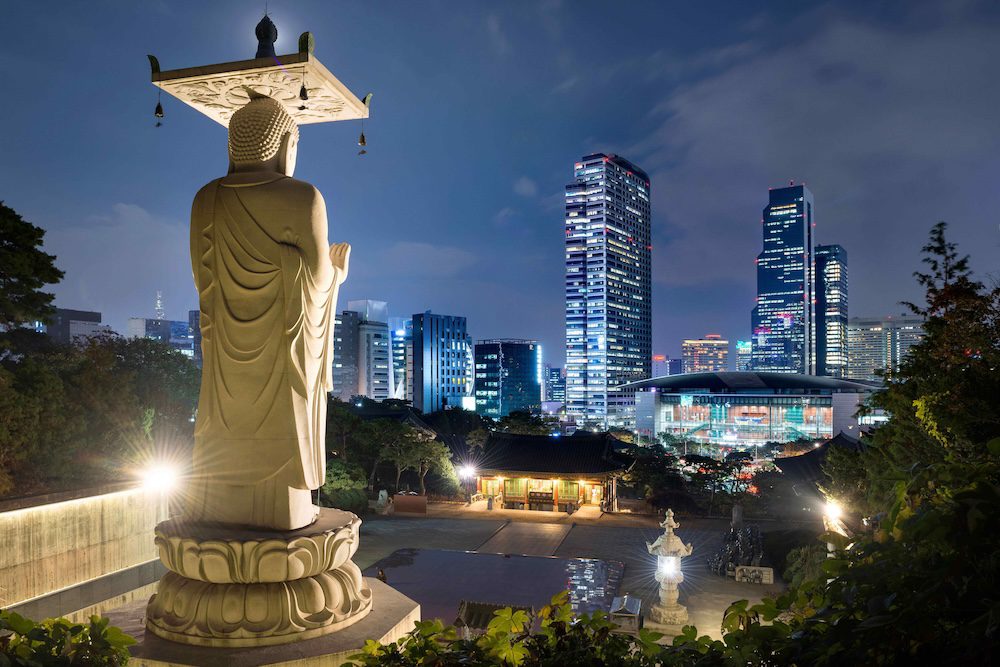
Both modern and traditional at Bongeunsa Temple in Seoul © IR Studio, Photo Korea
It’s a little out of the main tourist areas near Gyeongbokgung Palace, but it’s well worth the extra bit of travel. Surrounded by forests, flowers, and the sound of chanting monks, Bongeunsa has a fascinating history you’ll absolutely adore discovering.
*Any purchases made through affiliate links here help run this site. Support my blog here.
In this guide
- 1 Quick Guide: Bongeunsa Temple Seoul
- 2 Bongeunsa Temple History | 봉은사
- 3 Planning a trip to Korea?
- 4 How to Get to Bongeunsa Temple
- 5 Is there a Templestay Program at Bongeunsa?
- 6 What is there to see at Bongeunsa Temple?
- 7 What is the best time to visit Bongeunsa?
- 8 Are there any festivals at Bongeunsa Temple?
Quick Guide: Bongeunsa Temple Seoul
Bongeunsa Temple | Essential Info |
Address in English | 531, Bongeunsa-ro, Gangnam-gu, Seoul |
Address in Korean | 서울특별시 강남구 봉은사로 531 |
Operating hours | Open everyday from 5:00 to 22:00 |
Admission Fees | Free |
Best Transport Option | DIY by public transit: closest subway station is Bongeunsa Station on Line 9, Exit 1 |
Website |
Bongeunsa Temple History | 봉은사
Bongeunsa Temple was constructed in 794, in the 10th year of King Weongseong’s Silla Dynasty reign.
The temple was known as Gyeongseongsa then, and resided near the Royal Tomb of King Seongjong – a UNESCO site you can still see today at Seonjeongneung by Seolleung Station.
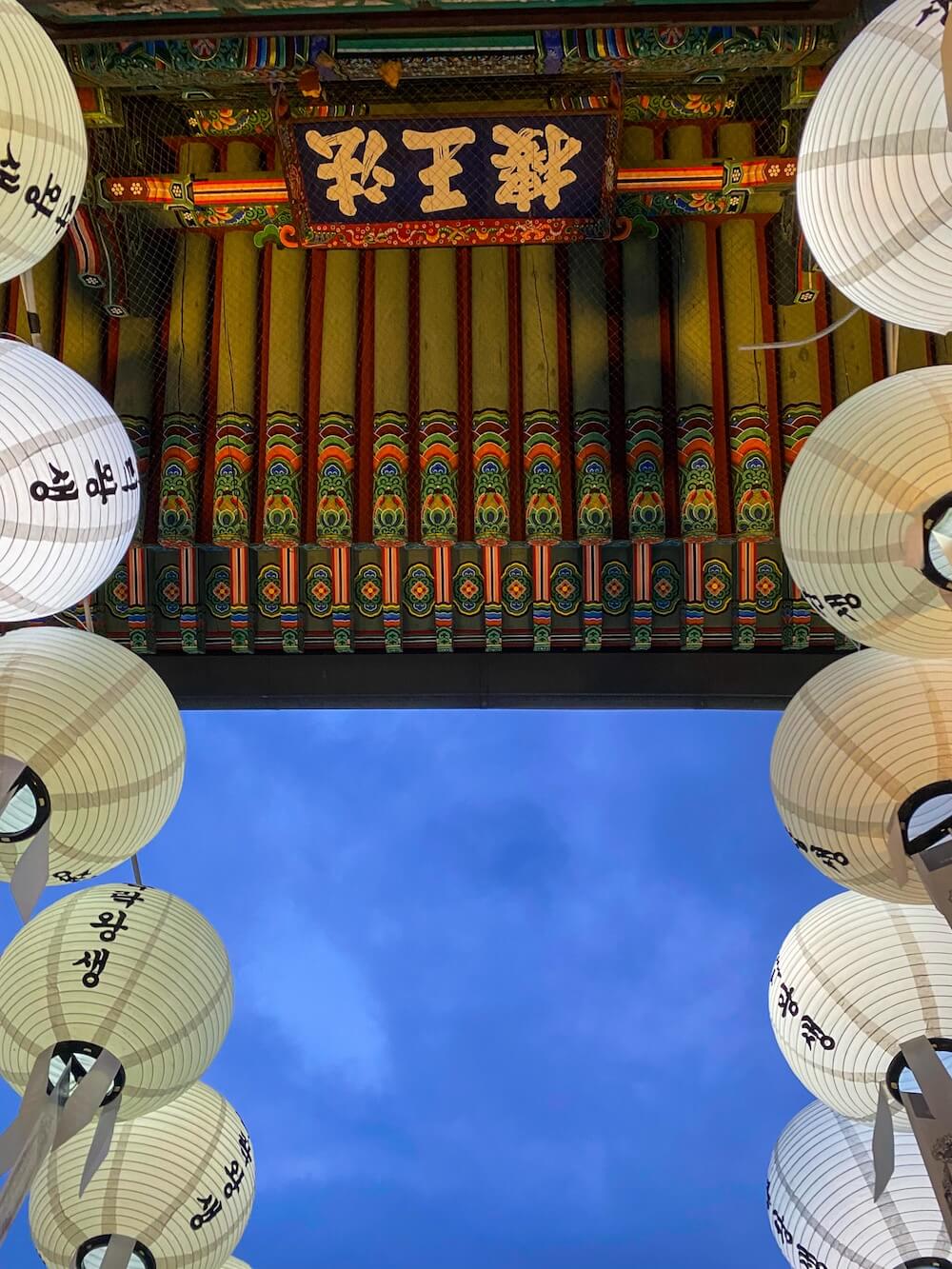
Bongeunsa has a more serene environment than Jogyesa.
In 1498, the Joseon Queen Jeonghyeon refurbished the original Gyeongseongsa, and renamed it Bongeunsa. Some 50 years later, King Myeongjong moved the temple to its current location near Starfield Coex Mall in Gangnam.
At the time, Bongeunsa was the largest Joseon Dynasty temple in Seoul, and thus was designated the head temple of the national Jogye Seon Order around 1550. It also held the honour of being the main Korean Buddhist Zen temple from 1551 to 1936.
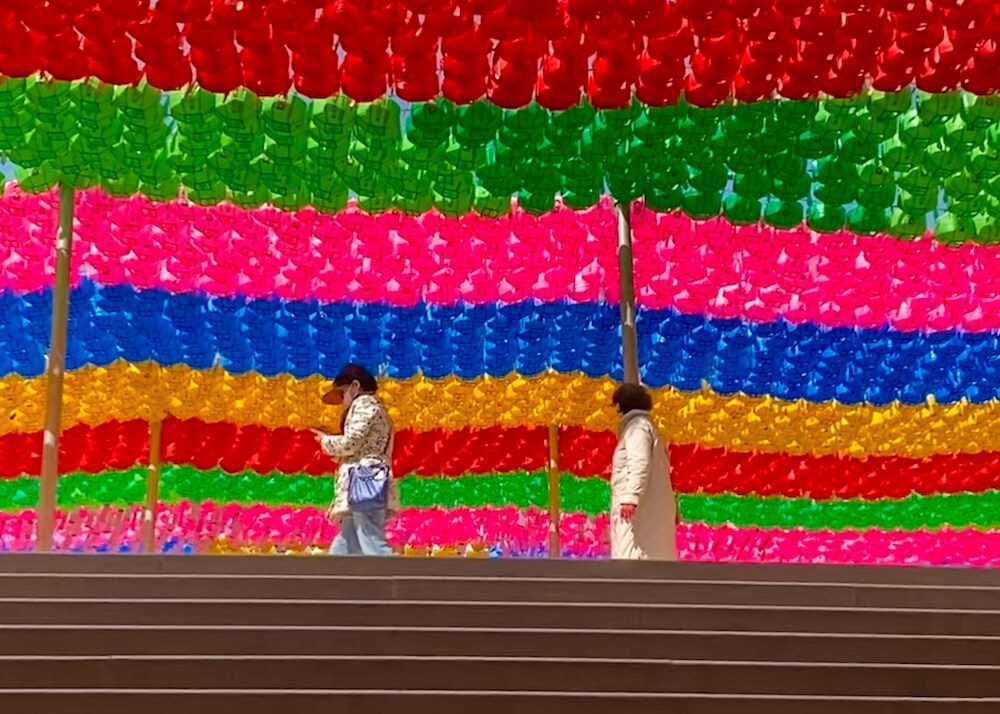
Bongeunsa Temple was moved to Gangnam in the 1500s.
The oldest remaining structure at the temple – a library that was constructed in 1856 – holds 3,479 Buddhist scriptures of 13 different types, including the works of Kim Jeong-hee (one of the greatest scholars and calligraphers of the era).
Most of Bongeunsa’s other buildings were unfortunately damaged by wars or fire at various times in its long history, but work continues even today to restore it to its full glory.
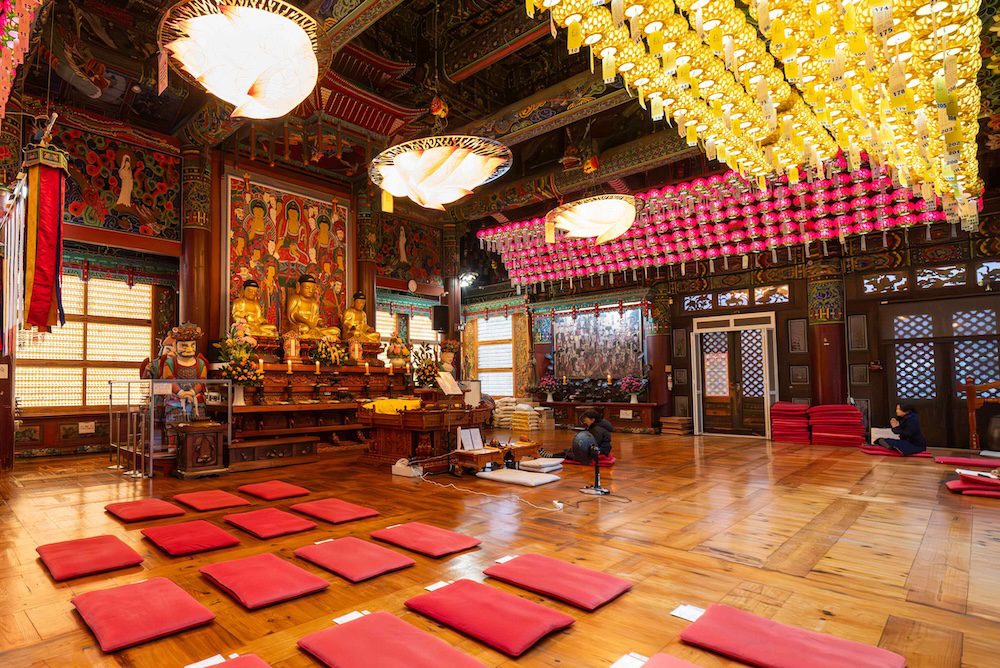
Efforts to restore Bongeunsa continue today © Im Taewon, Photo Korea
When you stand in the middle of super posh Gangnam now, it’s hard to believe that just 70 years ago, the area was nothing but farmland and orchards. All the trappings of modernity you see today were built up around Bongeunsa Temple.
Bongeunsa is an unexpected oasis of calm in the middle of one of Seoul’s busiest, most commerical districts – surrounded by forested hills, easy hiking trails, and a sacred atmosphere.
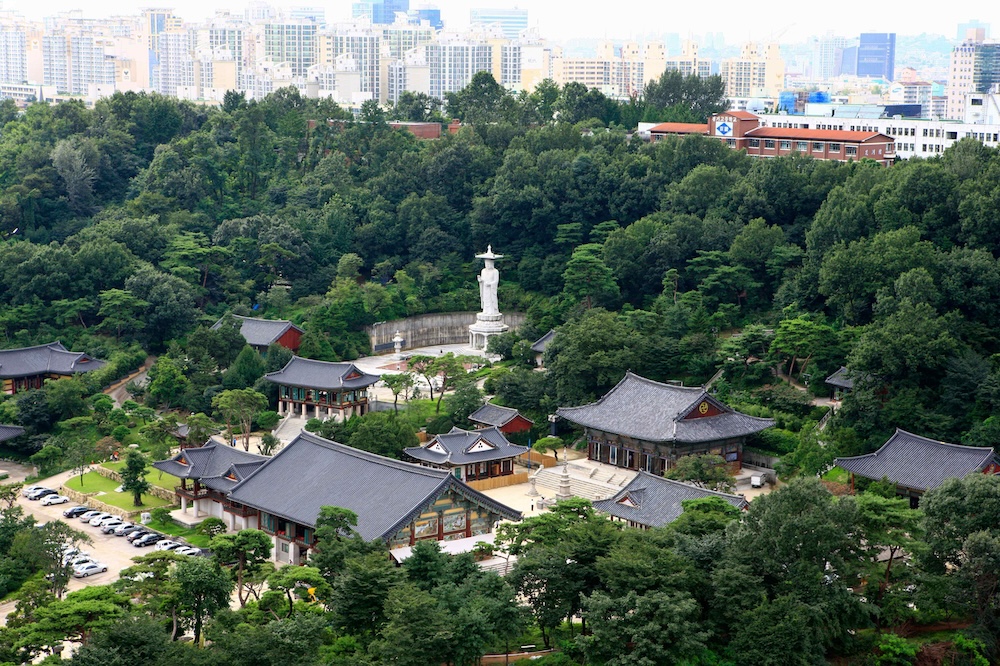
Posh Gangnam developed around Bongeunsa Temple © Kim Jiho, Photo Korea
With most Korean temples located in mountains or rural areas, this contrast of traditional and modern is rare, and should definitely be experienced!
It’s always seemed totally appropriate to me that Bongeunsa’s imposing statue of Maitreya – the Future Buddha – has watched over Seoul’s transformation from farmland into one of the most futuristic parts of the city.
Planning a trip to Korea?
Connect with other travellers | Ask and get answers to all your travel questions | Learn about all the best things to do in Korea | Join my Seoul and Beyond, South Korea Travel Planning Group on Facebook now.
South Korea Travel Essentials
Hotels and Other Accommodation
Tours, Admission Tickets, and Things to Do
Klook | Trazy | Get Your Guide | Fever |. Creatrip
Airport Transfers, Transit, and Transportation
Discounted AREX Incheon Airport Express Train
K Airport Limousine Bus from Incheon Airport
Private Airport Transfers from Incheon or Gimhae
Car Rentals (International Drivers Permit required)
Seoul to Busan KTX high speed rail tickets
Korean Express and Intercity Bus Reservations
Wifi, SIM Cards, and Portable Wifi
Airalo eSIM | unlimited data SIM cards | Portable and Pocket wifi
Money-Saving City Passes
Visit Busan Pass with FREE admission to 31 attractions + 77 discounted
Wowpass, Prepaid Debit Card for Cashless Payment in Korea (includes T-money Card)
How to Get to Bongeunsa Temple
Address: 531 Bongeunsa-ro, Gangnam-gu, Seoul (서울특별시 강남구 봉은사로 531 (삼성동))
Bongeunsa is one of the most accessible Buddhist temples in Korea. It’s a great one to visit if you’re traveling with small children or have other mobility issues.
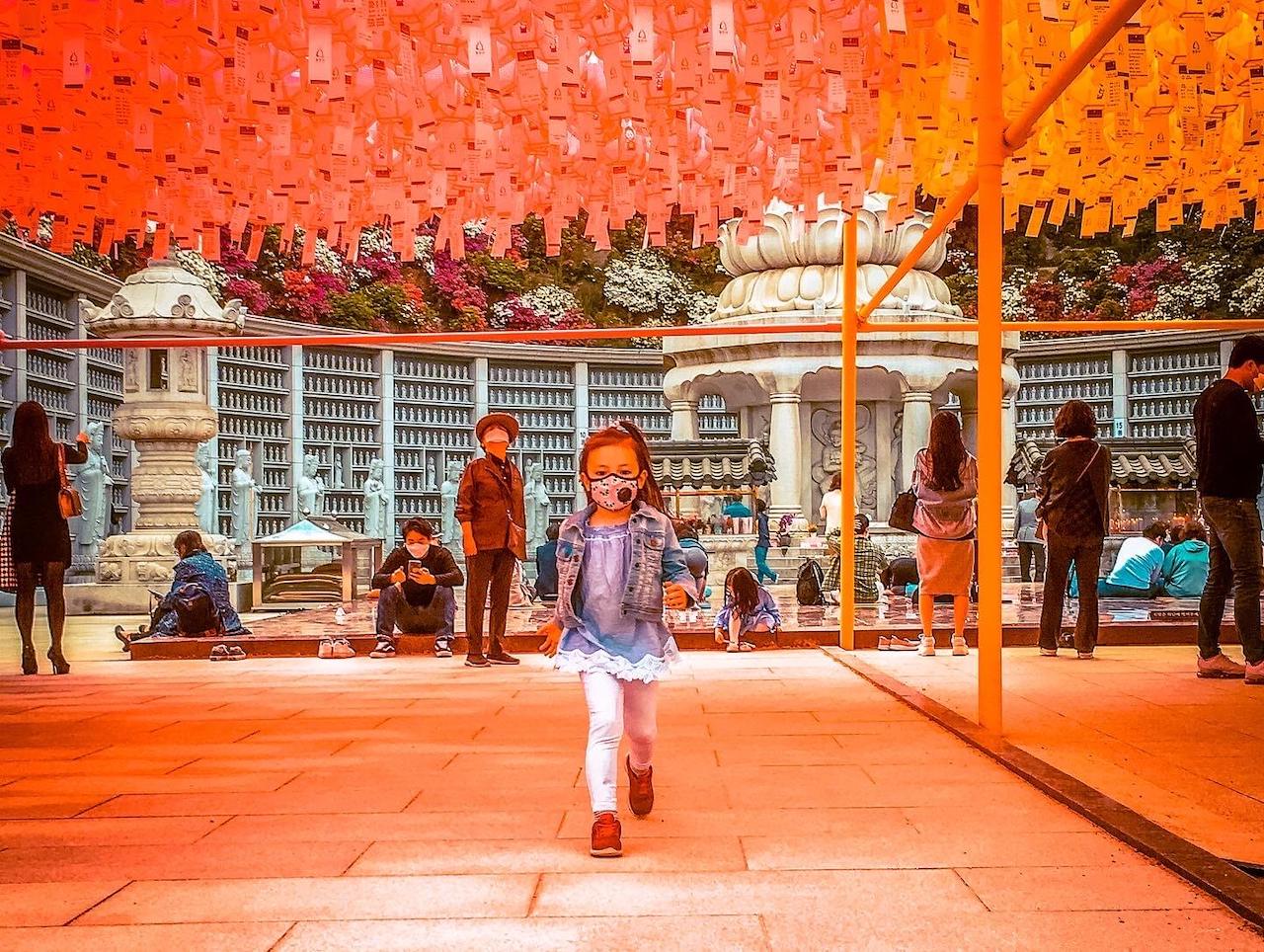
Bongeunsa is easy to visit with small children.
While there is on-site parking available, I recommend using public transit to visit this busy area of Seoul. Traffic in Gangnam isn’t something to be trifled with.
K-BEAUTY TREATMENTS | Gangnam is the place to go in Seoul for facials, skin treatments, and more. Pamper yourself with a facial or body treatment at Flow Spa, go on a ginseng journey at the Sulwhasoo flagship store and spa, or get a personal colour analysis, a major trend in Seoul these days.
By Seoul Subway
The closest subway station to the temple is Bongeunsa Station on Line 9. Take Exit 1, walk straight for a few minutes, and the temple will appear on your right-hand side. It’s impossible to miss.
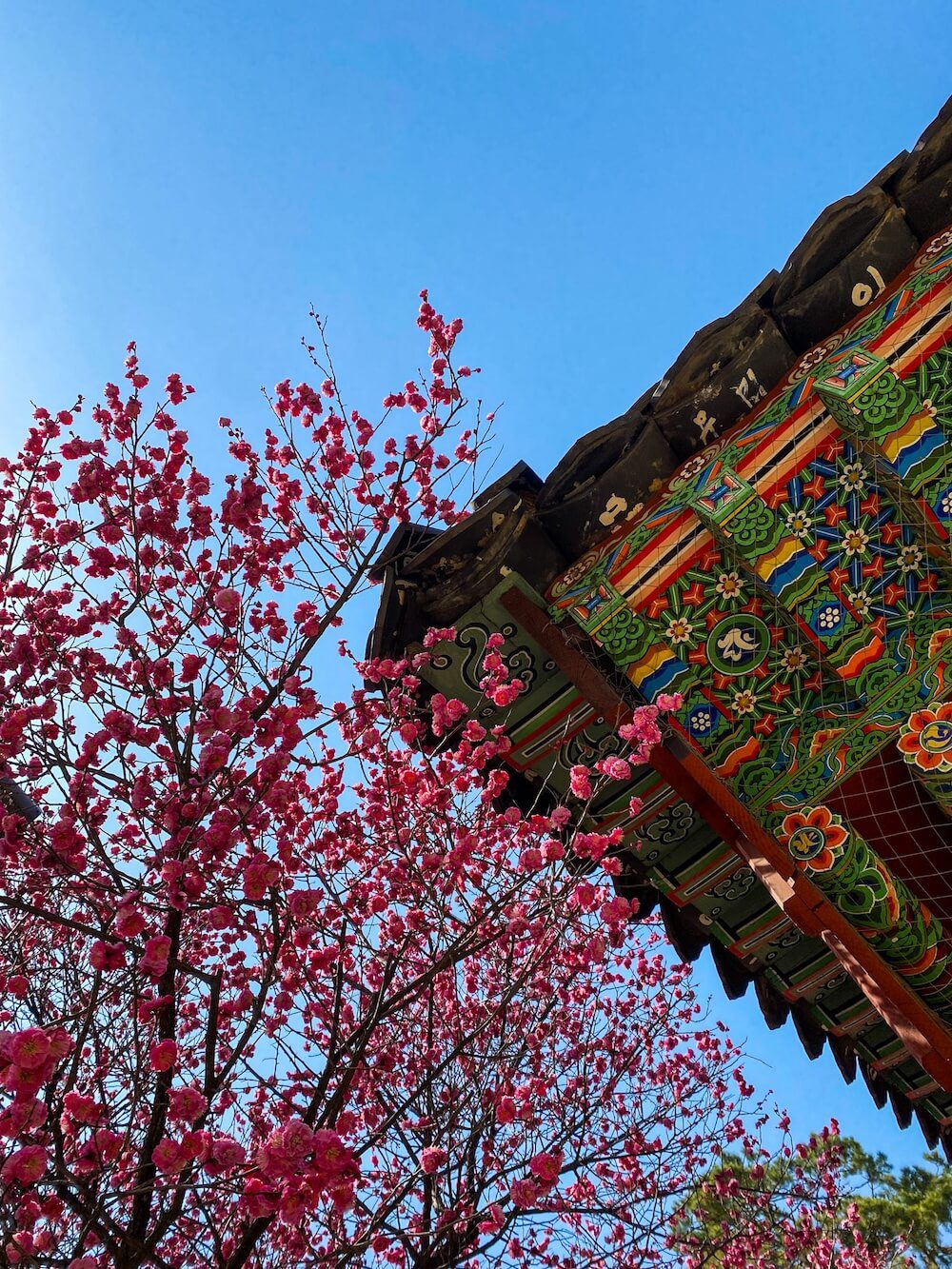
Bongeunsa is easily accessible by subway.
If you’re closer to Line 2, or plan to make a stop at Starfield Library or Coex Aquarium before visiting Bongeunsa Temple, get off at Samseong Station instead. Use Exit 5 or 6, then walk either through the mall or on the street in a northward direction.
On street level, make a left when you see Bongeunsa Station. If you’re underground in the mall, just follow the signs!
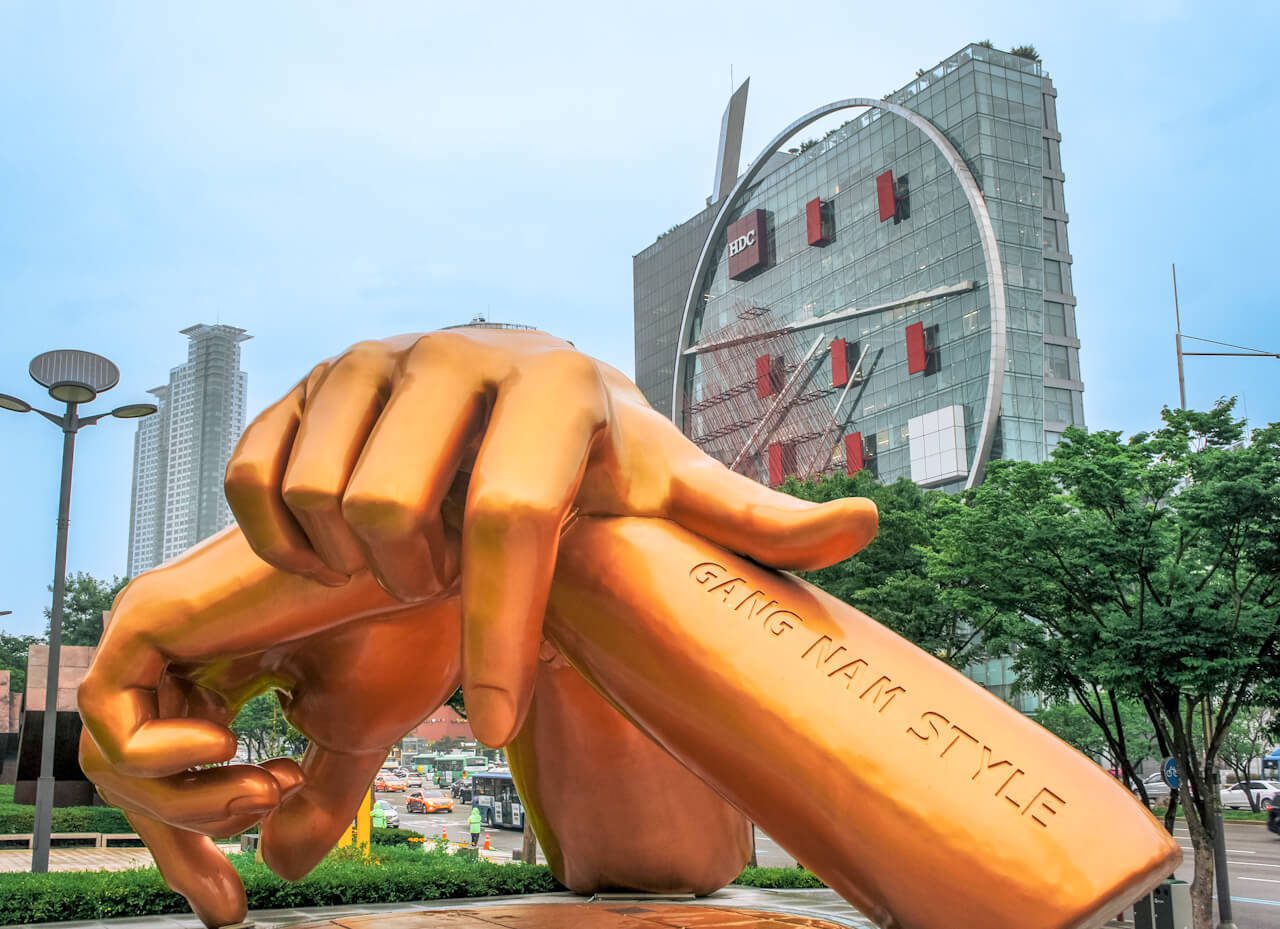
The Gangnam Style sculpture is at Starfield Coex Mall, near Bongeunsa Temple.
A T-money card, WOWPASS or a combo SIM / transit card makes public transit around Seoul super easy, so make sure to get that sorted out before you start traveling around Korea.
SIDE NOTE: There used to be a Seoul City Tour bus with a Gangnam route that passed by Bongeunsa, but it seems to be defunct. The last updated info I could find about it was from 8 years ago!
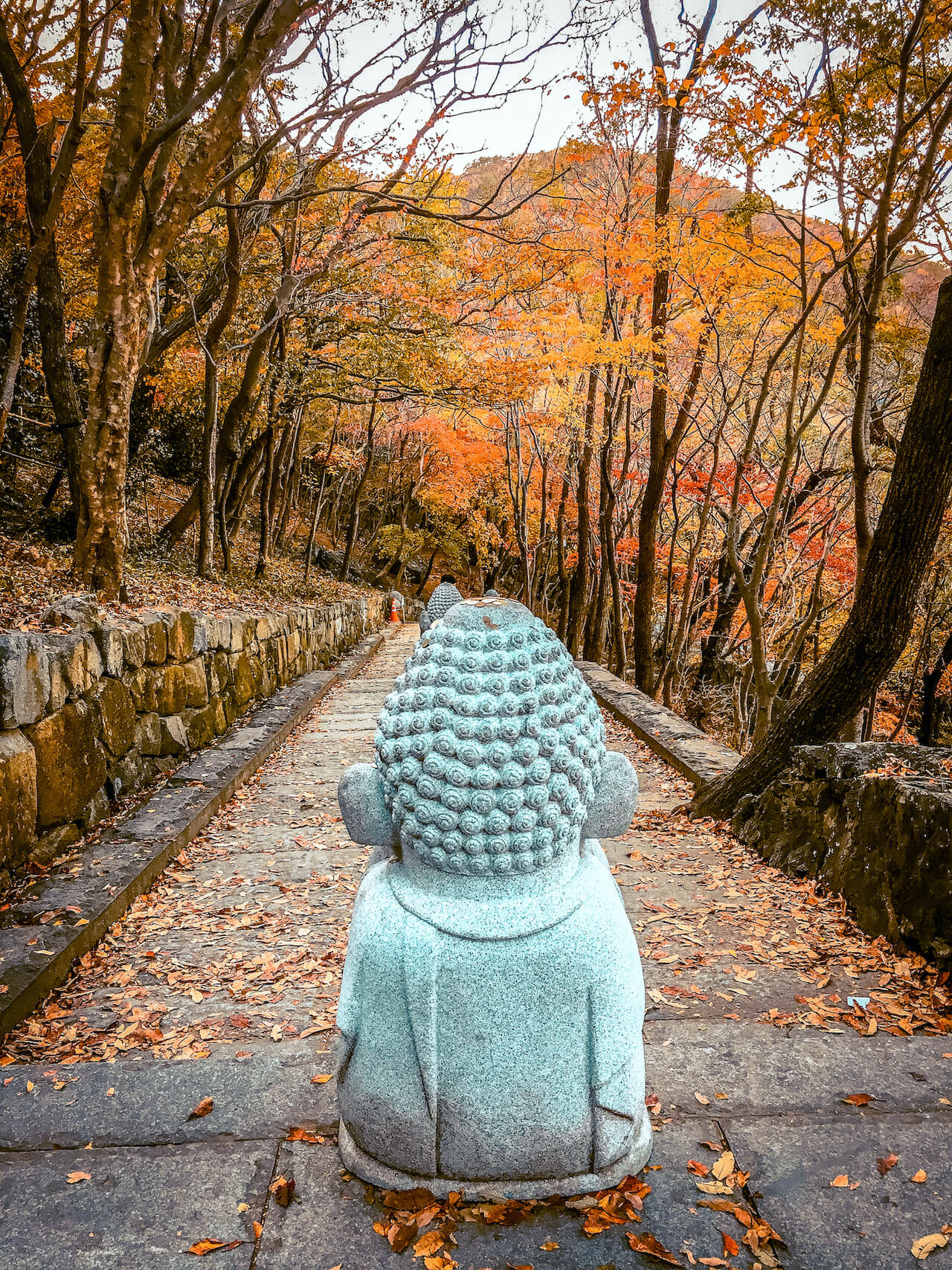
The hike up to Korean Buddhist Temples is 100% worth it.
Many Buddhist temples in Korea require a little hiking to get to, because they’re hidden away at the top of mountains. Don’t let the extra effort discourage you from visiting one.
Whether gorgeous Hyangiram Hermitage in Yeosu or Jingwansan near Eunpyeong Hanok Village, I have never been disappointed by the extra energy expended to get to a Korean Temple, and you won’t be either.

Eunpyeong Hanok Village and Jingwansa Temple are close to Bukhansan National Park.
JINGWANSA AND EUNPYEONG HANOK VILLAGE | Enjoy traditional Korean vibes at off-the-beaten path Eunpyeong Hanok Village and JIngwansa Temple, pick seasonal fruits, and explore gorgeous Gamaksan Mountain on this wonderful tour designed to get the best of each season. Check details here.
Is there a Templestay Program at Bongeunsa?
Participating in a templestay program in Korea is a wonderful way to learn about Buddhism. Bongeunsa Temple offers a few different ways to experience monastic life.
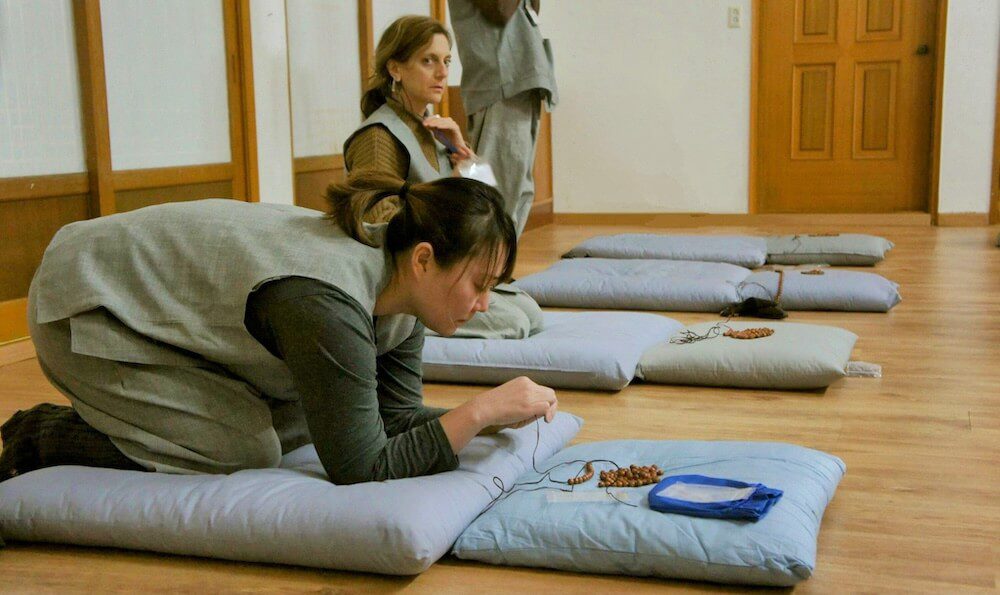
A templestay in Korea is a great way to learn about Buddhism.
Bongeunsa Overnight Templestay
The regular templestay is a 2 day / 1 night program that takes place on the 1st Saturday to Sunday of each month.
Designed to provide a taste of Buddhist life, you’ll participate in a Da-Seon Tea Ceremony, copy sutras in golden ink, meditate, have tea with a monk, and try to make it through the 108 prostrations (not easy!). A temple tour and delicious temple cuisine is also included.
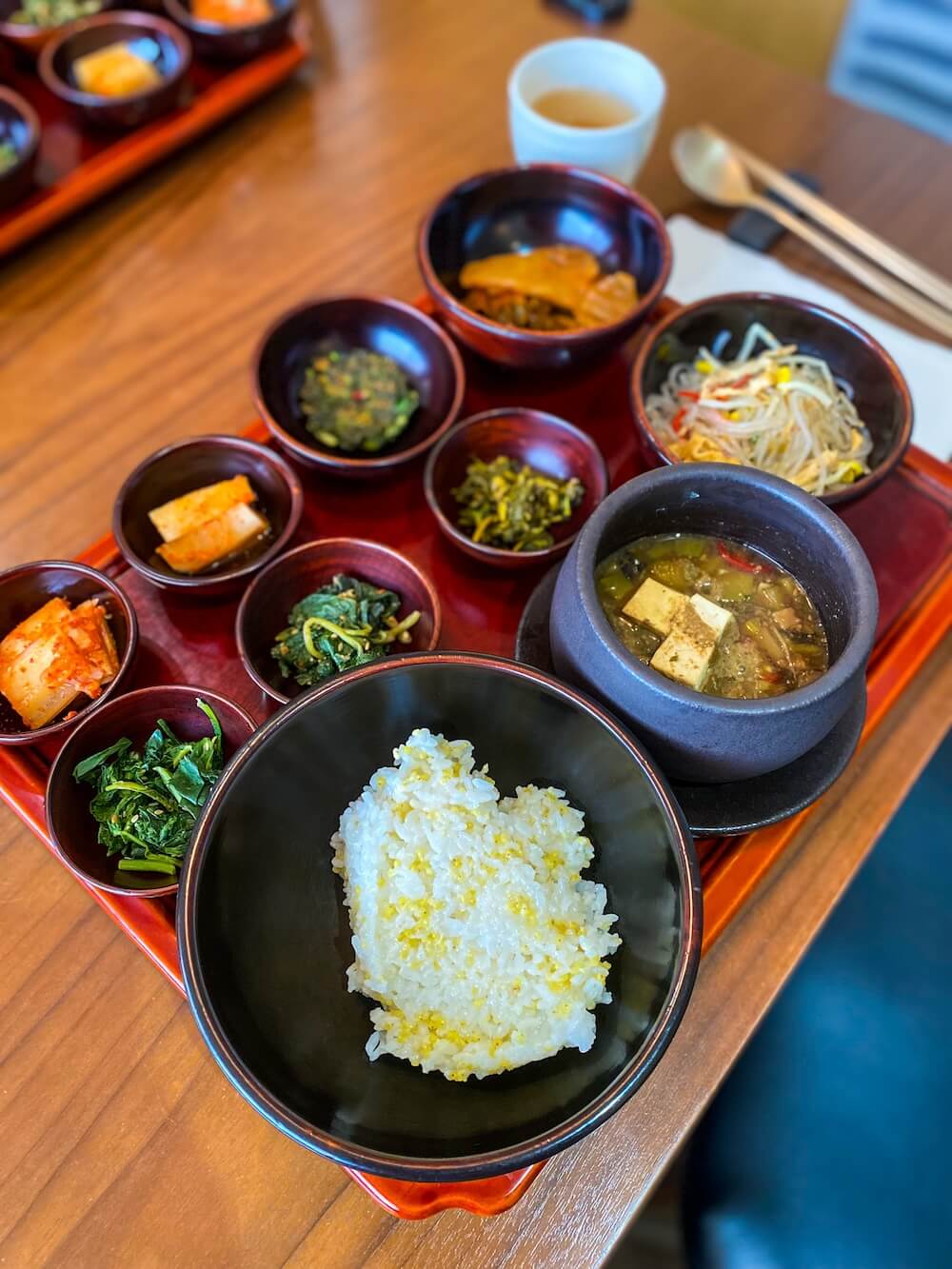
Buddhist temple cuisine is delicious and nutritious.
The overnight templestay program is available for participants aged 14 and up, and costs 120,000 won. The rules are quite strict, so be sure to check them out in detail on their website when you reserve.
As you can imagine, this program is incredibly popular, so it’s recommended that you reserve at least 1 month in advance.
Bongeunsa Templelife Program
The Templelife program takes place every Thursday, from 2:00 to 4:00pm. You’ll enjoy a tour of Bongeunsa Temple, then experience a Da-Seon tea ceremony and try your hand at Sagyeong (copying sutras).
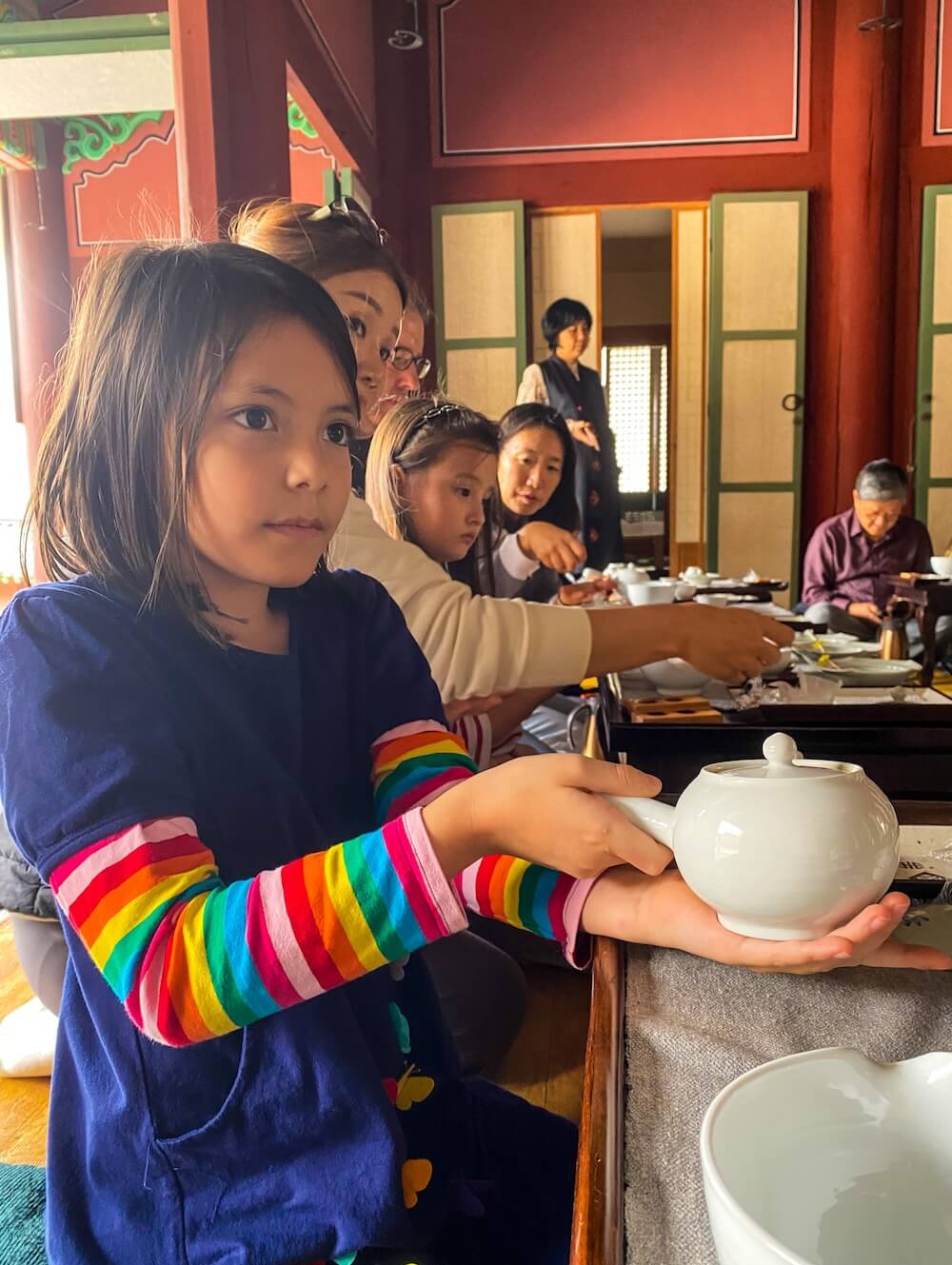
Da-seon is a meditative tea ceremony.
There is no age limit for this program, so it’s a great one to attend with your kids. It costs 30,000 won per person.
AFTERNOON TEA IN SEONGSU-DONG | Relax with signature teas, tea lattes, tea cocktails(!) and unique desserts while watching the world go by at Magpie and Tiger Tearoom in trendy Seongsu-dong. Check details here.
What is there to see at Bongeunsa Temple?
Aside from the temple complex which has stood for millenia, make sure to seek out the striking stone statue of Maitreya, which stands at a height of 28-metres. It’s one of the tallest stone statues in the country, and you are welcome to grab a cushion and meditate on the platform in front of it.
Make sure to remove your shoes before you step onto the platform though.
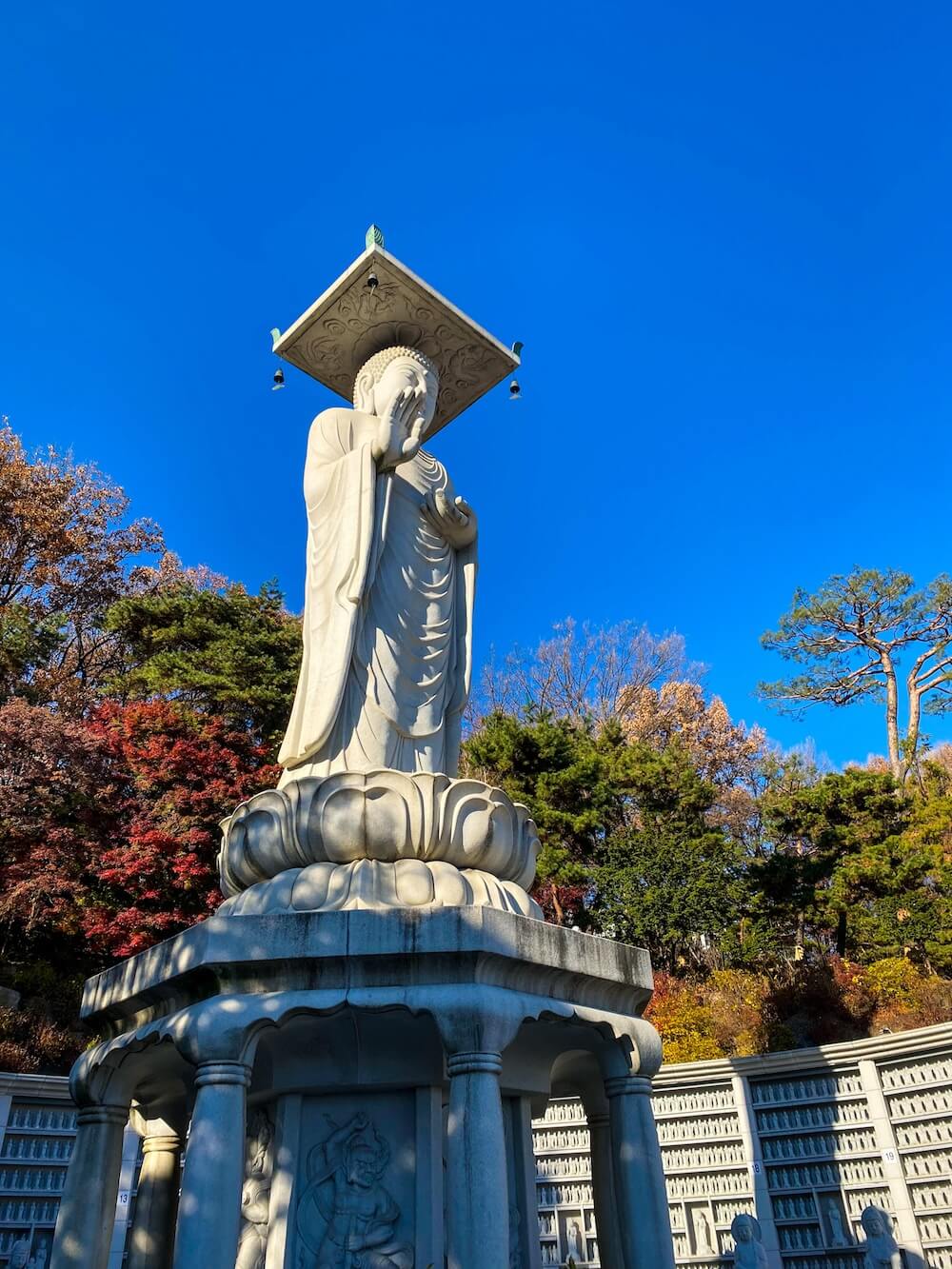
Matreiya is imposing.
If you time your visit to Bongeunsa for 4:10 or 18:40, you’ll be treated to a percussion ceremony that’s performed by the temple monks. It’s meant to awaken spirits from the earth, water, sky, and underground using a drum, wooden fish, cloud drum, and gong.
I’m always totally thrilled whenever I stumble upon ANY kind of drumming in Korea, but it somehow feels especially remarkable in a temple setting.

It’s always a joy to hear the beat of the drum.
DMZ TOUR | If there’s one tour you join in Korea – let it be to the DMZ or Demilitarized Zone between North and South Korea. It’s one of a kind, and the most interesting places can only be accessed via group tour. Learn about the Korean War, hike the Third Infiltration Tunnel, and see into North Korea at the Dora Observatory. Check details here.
What is the best time to visit Bongeunsa?
Bongeunsa is worth visiting multiple times to experience its changing seasons, events, and activities. From cherry blossoms to lotus flowers, each month brings something new and beautiful to contemplate at the temple.
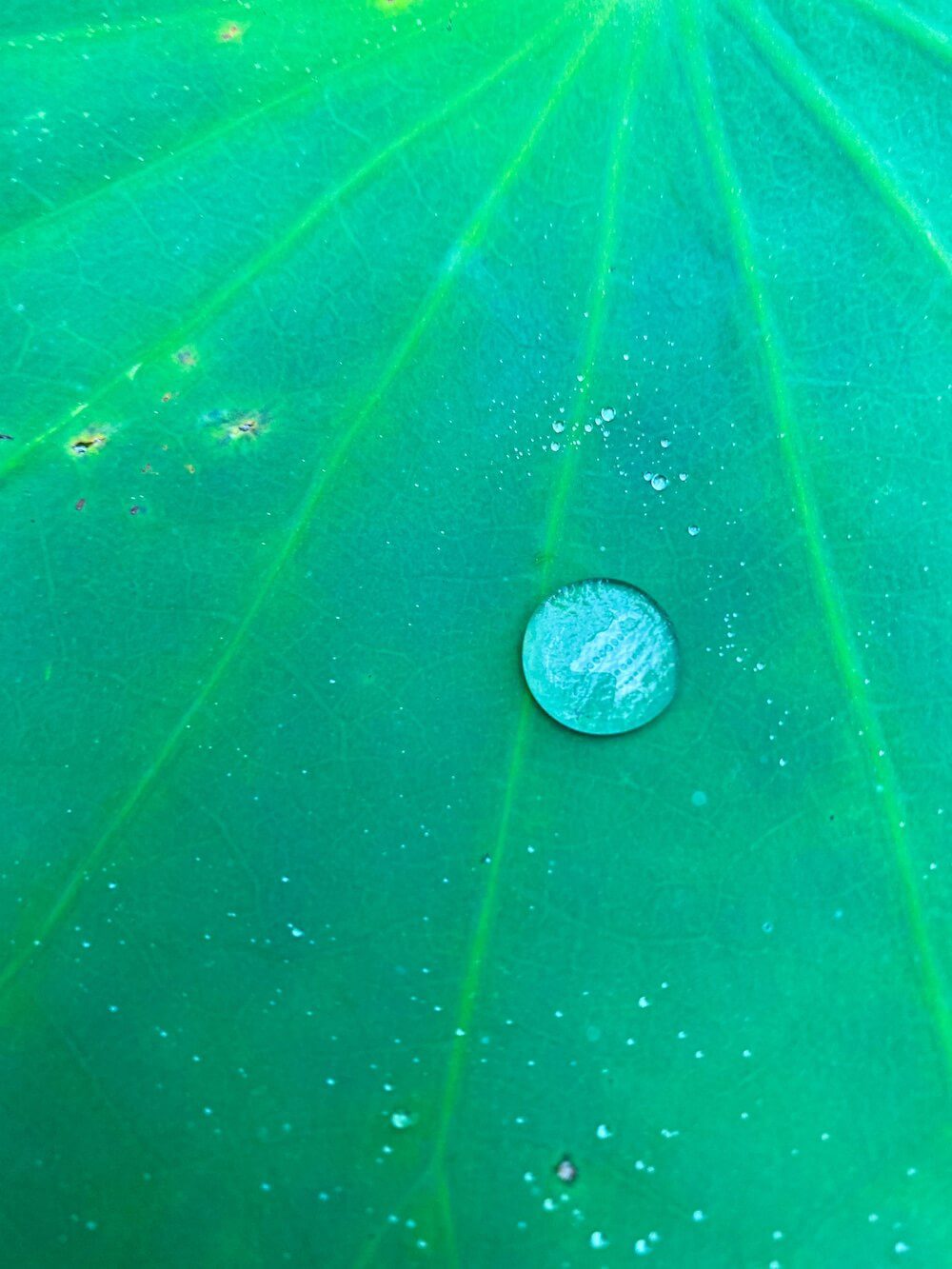
Summer brings enchanting lotus to Bongeunsa.
It’s also a good idea to visit during both daylight hours, and after sunset. Bongeunsa is open every single day from 5:00 to 22:00, and each hour feels just a little bit different.
I always find the hush of darkness at the temple to allow a beautiful contemplative space that’s hard to find these days.

The hush of darkness is beautifully contemplative.
Spring at Bongeunsa Temple
While I don’t want to influence your perceptions too much, I think it’s safe to say that the months of March, April, and May at Bongeunsa Temple are some of the best.
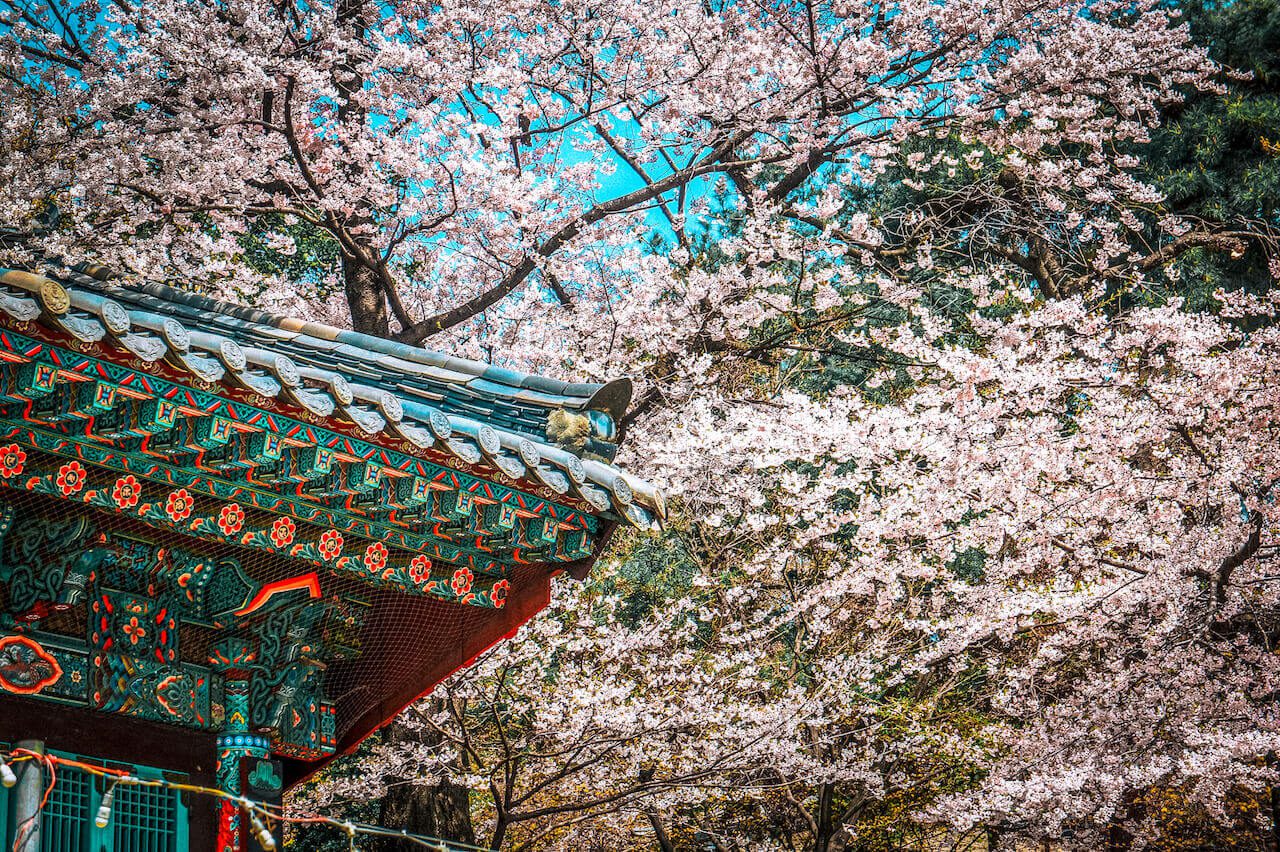
Cherry blossoms at Bongeunsa Temple in spring.
There’s a very good reason for this, that goes beyond the pretty plum blossoms, fragile cherry blossoms, and other flowers that bloom at the temple in spring.
No, the main reason is that Buddha’s birthday is celebrated during spring in Korea. Buddhist temples all across the country mark this important day with a month of gorgeous lanterns and plenty of exciting events.
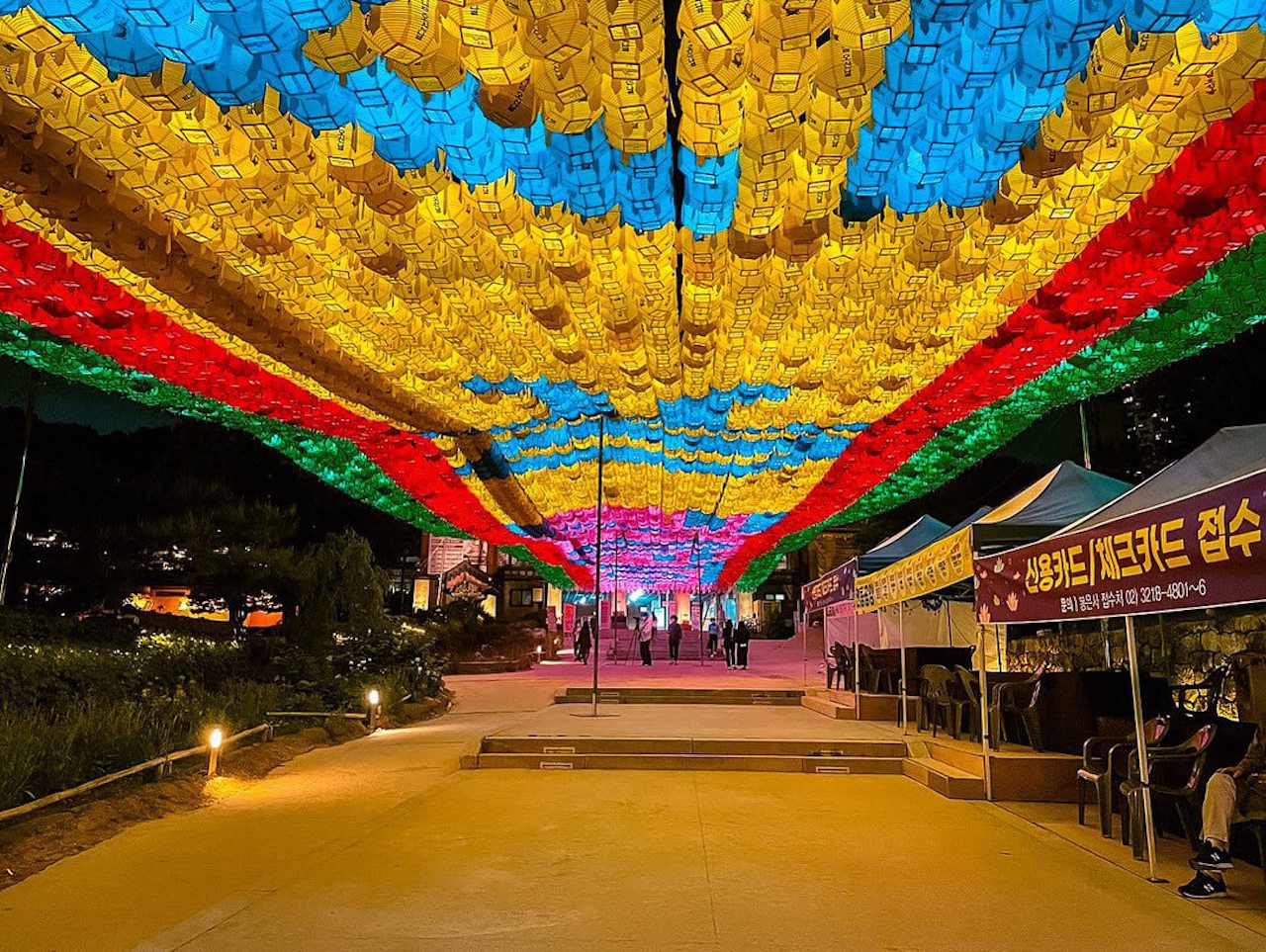
In spring, Bongeunsa is alive with colour and light.
Don’t miss the spectacular Lotus Lantern Parade and Festival that shuts down major streets in Seoul for the occasion. The sight of thousands upon thousands of lanterns glowing against the night sky is truly unforgettable.
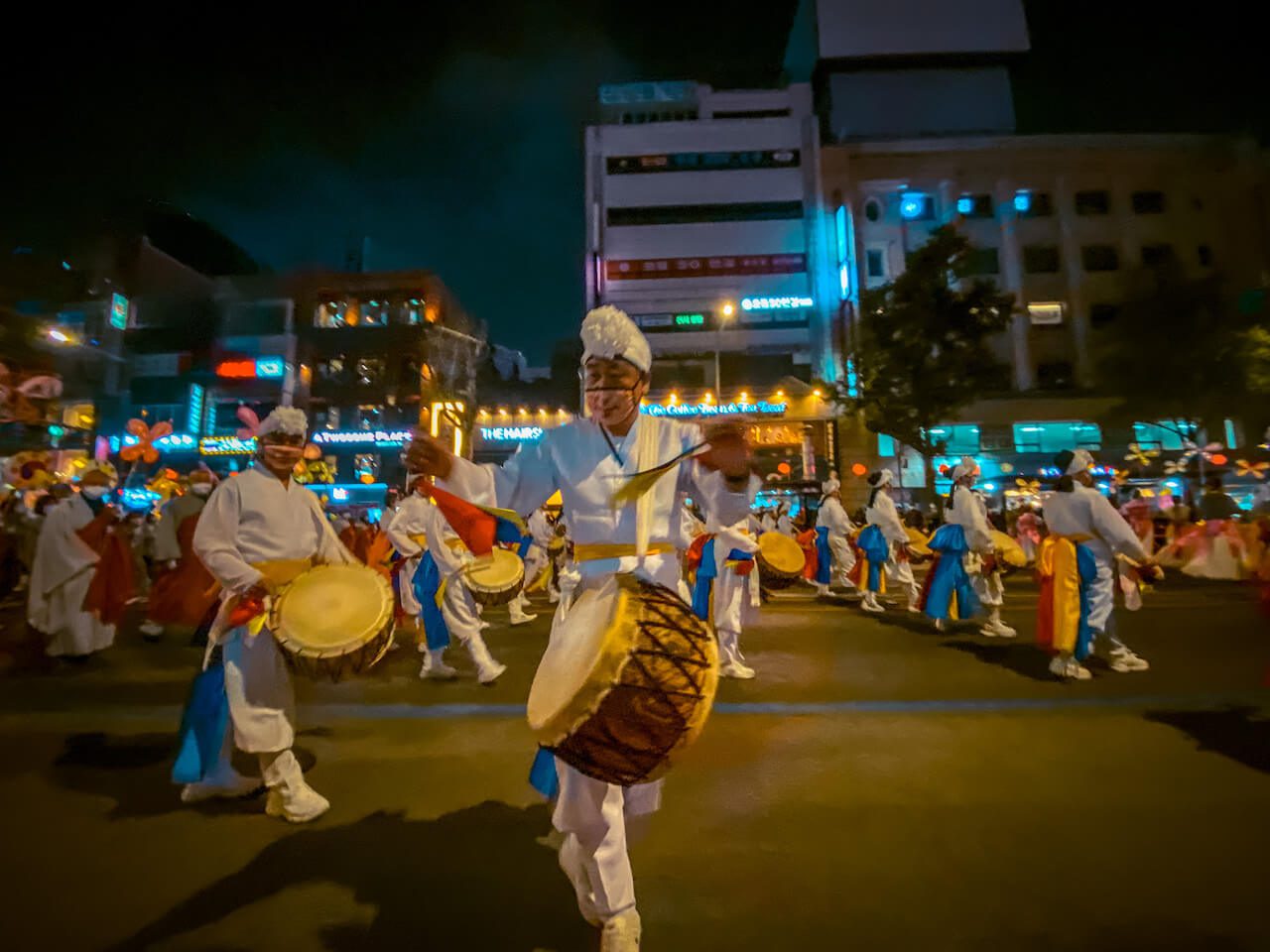
The Lotus Lantern Festival and Parade is one of Seoul’s biggest events!
The dates for this festival are dictated by the Lunar Calendar, so you’ll have to check for updated information each year.
In 2026, the Lotus Lantern Festival and Parade take place on May 16th and 17th. Lotus lanterns at Bongeunsa Temple stay up for a full month though – so you can still see them, even if you’re not in Seoul for the festival itself.
Summer at Bongeunsa Temple
Traveling in Korea during the summer months of July and August can be a challenge due to the extreme heat and humidity, but there is one particularly special flower to look forward to.

Lotus flowers bloom in hot, hot heat.
Every summer, Bongeunsa holds a lotus flower festival, and it’s a delight to behold. I mean – lotus flowers and a temple together – is there really anything more perfect?
It’s almost enough to make you forget the torrid temperatures.

Lotus flowers at Bongeunsa Temple during summer.
Autumn at Bongeunsa Temple
The fall months are among Korea’s best, with cobalt skies, brilliant autumn leaves, and a packed festival calendar.
Plan a visit to Bongeunsa Temple for mid-October to mid-November, and you’ll be rewarded with a gorgeous palette of fall colours, punctuated by traditional Buddhist architecture.
And while it is possible to see gorgeous fall foliage everywhere in Seoul, the forested hills surrounding the temple are an oasis of serenity that’s hard to come by in the middle of the hectic city,
SEORAKSAN + NAMI ISLAND | Seoraksan National Park is beloved for its spectacular autumn foliage and proximity to Seoul. Enjoy it and Nami Island (another autumn hotspot) on this excellent one day tour. Check details here.
Winter at Bongeunsa Temple
If you’re lucky enough to catch snowfall in Seoul, head straight to Bongeunsa Temple for gloriously tranquil scenes. You’ll hear nothing but the crunch of snow beneath your feet, and the sounds of the city muted by a soft blanket of snow,
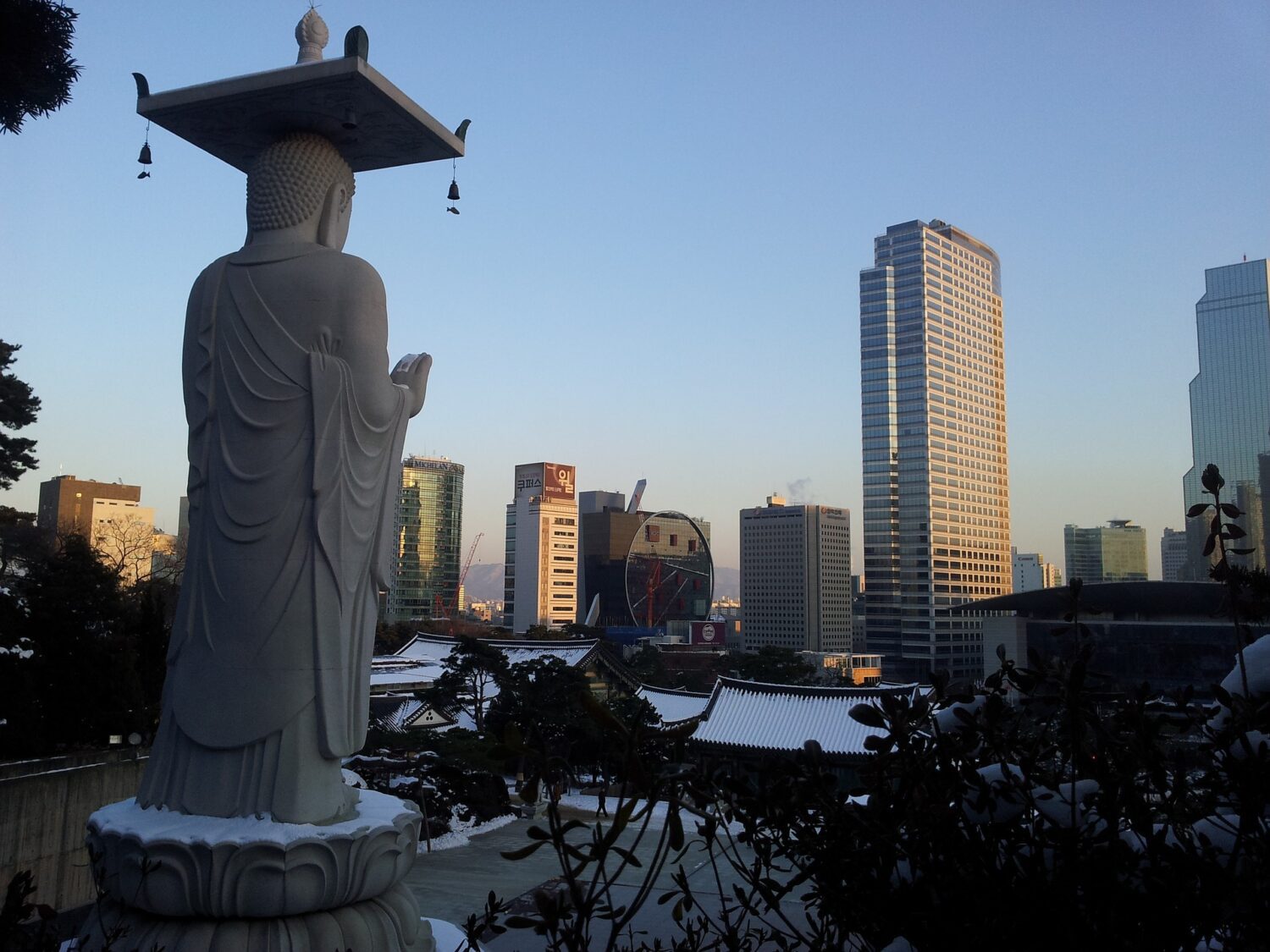
Bongeunsa is incredibly tranquil in winter time.
Make sure to bundle up and wear warm footwear if you plan to spend an extended period of time outside during the winter months in Korea.
You’ll need all that gear to check out fun winter events like the Sanjeong Lake Sledding Festival, or Garden of Morning Calm Lighting Festival anyway!
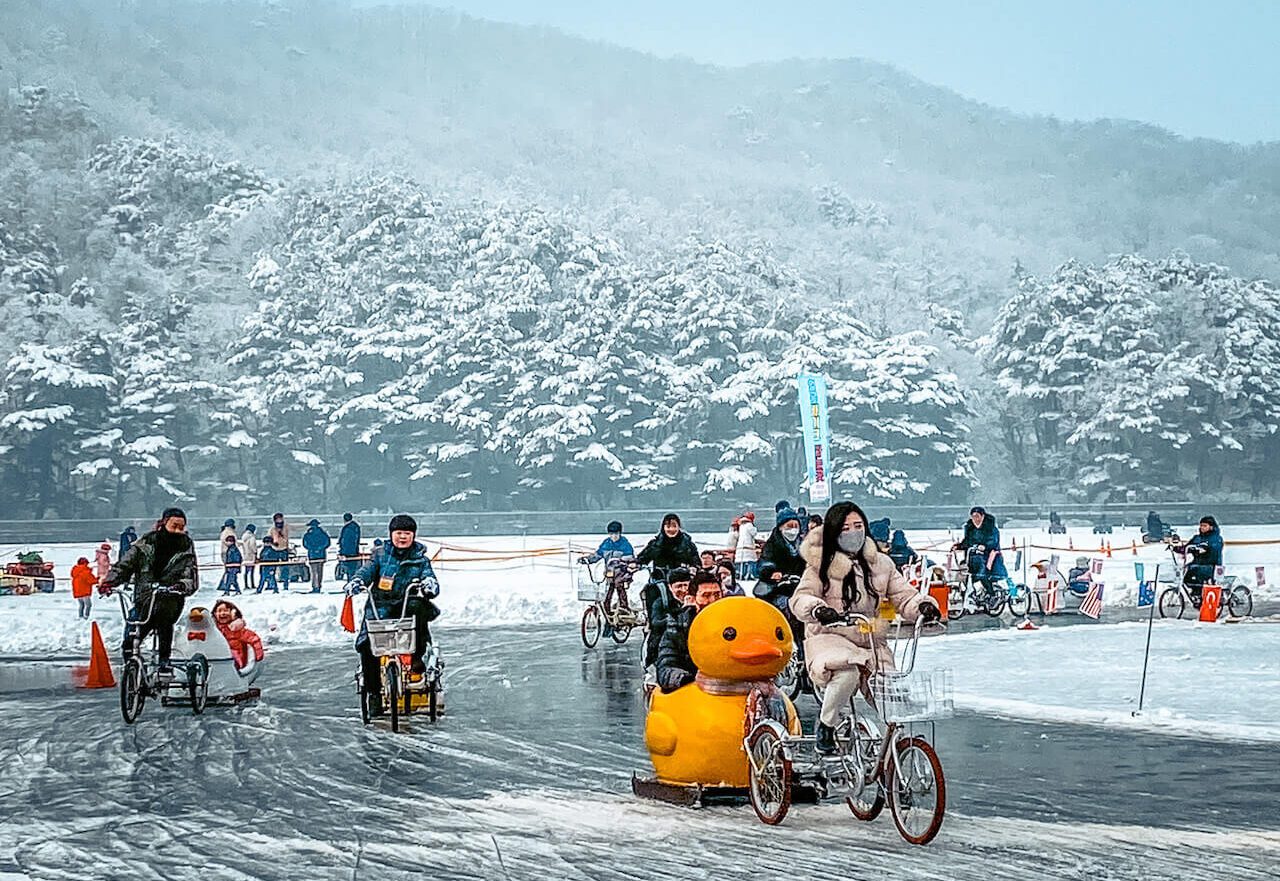
Rubber duck sleds at Sanjeong Lake are TOO adorable.
SNOWY LAND SLED PARK | Whether you just want a shuttle bus to Vivaldi Ski Resort, a Snowy Land sledding pass, or a full on package including winter clothing, ski pass and private lessons, it’s easy to customize a package perfect for your needs. Check details here.
Are there any festivals at Bongeunsa Temple?
There are a few special events that take place at Bongeunsa every year. Entrance into the temple is always free, so if your timing is right, it’s a great way to enjoy it on a deeper level.
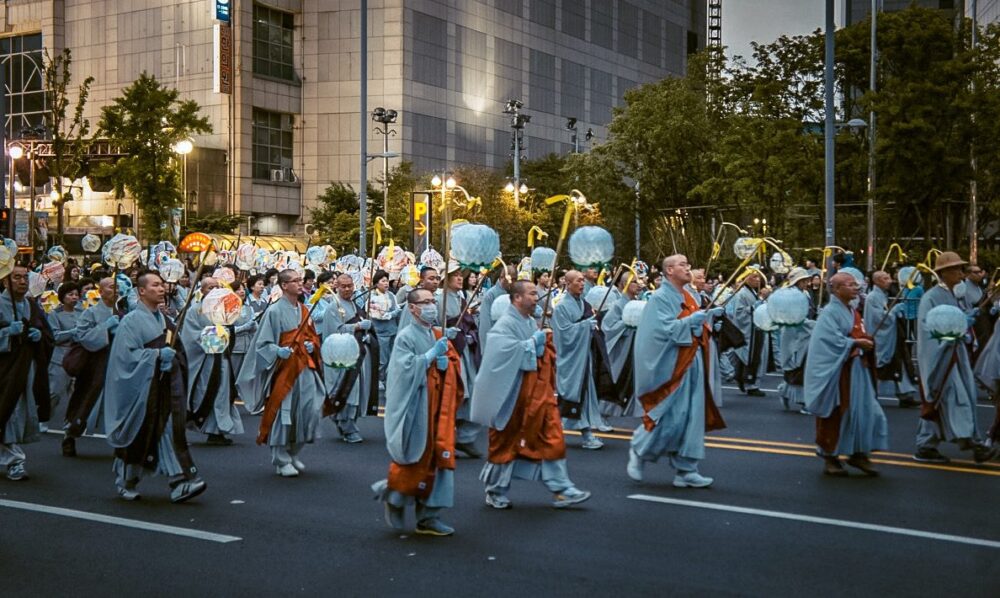
Buddhist monks at the Lotus Lantern Parade.
Lotus Lantern Festival
Festival Dates: April 25th – 27th, 2025
During the lotus lantern festival in Seoul, streets and temples around Korea are decorated with beautiful lotus lanterns.
While the main events (parade and performances) take place over the course of a weekend, Jogyesa, Bongeunsa and Cheonggyecheon Stream are illuminated with lanterns for an entire month.
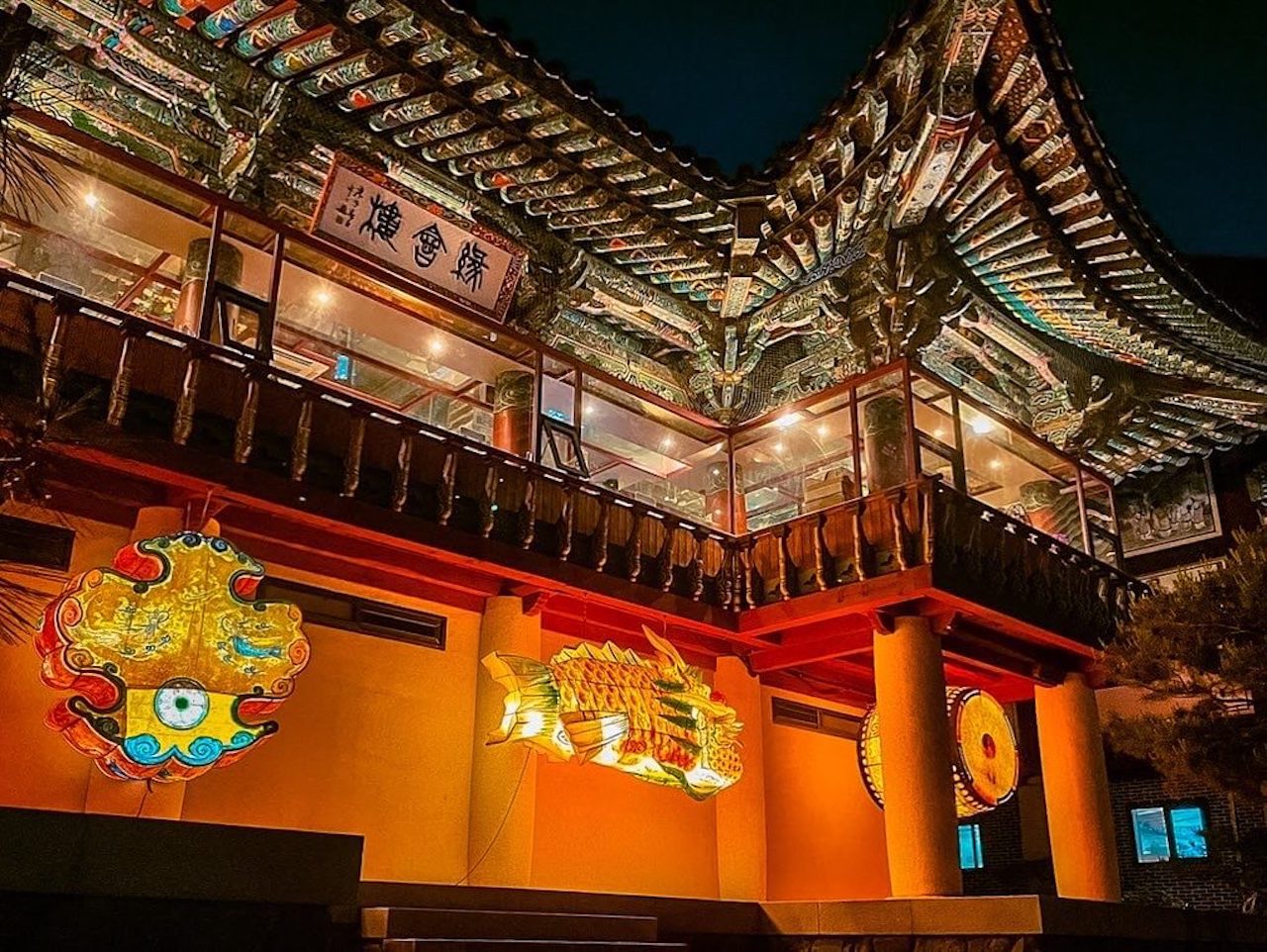
Lanterns are on display at Bongeunsa, Jogyesa, and Cheonggyecheon Stream for the festival.
Jeongdaebulsa
When: 9th day of the 8th month of the Lunar Calendar
Jeongdaebulsa is a single day Buddhist ceremony that takes place in autumn. The date changes every year, based on the lunar calendar.
During this sacred ceremony, monks recite the Beopseongge (Buddhist rites), while carrying the 3,479 Buddhist scriptures that are stored at Bongeunsa Temple, on their heads.
Bongeunsa Lotus Flower Festival
Festival Dates: early July to early September
Every summer, Bongeunsa hosts a lotus flower festival, with both pink and white lotus flowers on display. Admission is free, and there are several places to capture photos with these enchanting flowers as a background.

The Bongeunsa Lotus Flower Festival.
Did this article help you? Writers (and moms especially) need caffeine!
Help support my small business with a cup of coffee.
Bongeunsa Temple: Essential Info and FAQs
Is a visit to a Buddhist Temple in Korea on your list of must-dos? Bongeunsa Temple is a lovely choice.


